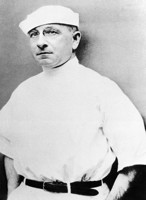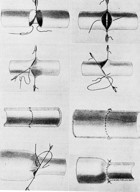Pioneering Surgery to Repair Blood Vessels and Transplant Organs

Alexis Carrel at Rockefeller Institute after World War I. Courtesy of Theodore Malinin
Any number of injuries can sever a blood vessel—a knife cut or a bullet wound, for example. If the bleeding isn't stopped and the circulation restored, cell and tissue death will occur, commonly leading to gangrene. At the beginning of the twentieth century, Alexis Carrel (1873-1944) developed the first effective surgical techniques for stitching together blood vessels, and closing wounds in blood vessel walls, in order to restore circulation. For this work he was awarded the Nobel Prize in 1912. These techniques and Carrel's subsequent research laid the groundwork for organ transplantation and heart surgery.


Carrel-Lindbergh perfusion pump. Courtesy of the Rockefeller Archive Center
Carrel used sharp, small, round needles to sew together blood vessels, using very fine sutures made of silk. He coated both the needles and the sutures with Vaseline, which rubbed off and sealed the puncture from the needle. These precautions prevented injury to the vessel wall, and the formation of blood clots after surgery. After he arrived at the Rockefeller Institute for Medical Research in 1906, Carrel expanded on his technique. He developed ways to preserve veins and arteries outside an animal's body so they could be used for surgery later. He experimented successfully with transplanting kidneys and other organs in dogs, and with reattaching severed limbs. He also was able to perform direct blood transfusions, saving the life of an infant by connecting an artery from the father's arm to a vein in the baby's leg.
Carrel's interest in organ transplant led him to explore methods of tissue culture. In the 1930s, working with Charles Lindbergh, the celebrated pilot and skilled engineer, Carrel invented an apparatus that could keep animal organs alive outside the body by perfusing them with a blood-like fluid. Carrel had also became well known during World War I for his work at a field hospital on the front lines in France. There, in collaboration with biochemist Henry Dakin, he devised a technique for treating deep battle wounds by surgical removal of tissue and cleansing with antiseptic solution.
Alexis Carrel was born and educated in Lyons, France, and he received his medical degree from the University of Lyons in 1900. He remained there, teaching and doing research, until 1904. That year, after a short stay in Montreal, he took a research position at the University of Chicago. In 1906, Simon Flexner invited Carrel to join the Rockefeller Institute, where he remained until 1939. Carrel returned to France that year, as World War II began in Europe. During the early 1940s, in Paris, he headed a Foundation for the Study of Human Problems, which was supported by the Vichy government. Carrel's extreme views on politics and religion remain a subject of controversy.
Selected Publications
Carrel A. The transplantation of organs: a preliminary communication. 1905 [classical article] Yale J Biol Med, 2001, 74:239-241
Carrel A, Guthrie CC. Anastomosis of blood vessels by the patching method and transplantation of the kidney. 1906 [classical article] Yale J Biol Med, 2001, 74:243-247
Carrel A. Landmark article, Nov 14, 1908: Results of the transplantation of blood vessels, organs and limbs. JAMA, 1983, 250:944-953
Further Reading
The Nobel Prize in Physiology or Medicine 1912
http://nobelprize.org/nobel_prizes/medicine/laureates/1912/index.html
Corner GW. A History of the Rockefeller Institute, 1901-1953: Origins and Growth. (New York: Rockefeller Institute Press, 1964)
Malinin TI. Surgery and Life: The Extraordinary Career of Alexis Carrel. New York: Harcourt Brace Jovanovich, 1979
McKellar S. Innovation in modern surgery: Alexis Carrel and blood vessel repair. In Stapleton DH, Creating a Tradition of Biomedical Research: Contributions to the History of The Rockefeller University. New York: The Rockefeller Univ Press, 2004
Links
Papers of Alexis Carrel at the Rockefeller Archive Center
http://www.rockarch.org/collections/individuals/ru/
PBS: Red Gold, the Epic Story of Blood
http://www.pbs.org/wnet/redgold/innovators/bio_carrel.html
Harvard University, Collection of Historical Scientific Instruments, Carrel-Lindbergh Perfusion Pump
http://dssmhi1.fas.harvard.edu/emuseumdev/code/emuseum.asp?style=browse¤trecord=1&page=search&profile=objects&searchdesc=carrel&quicksearch=carrel&sessionid=CA85E781-71F6-4623-8A82-C36FDDC50A3B&action=quicksearch&style=single¤trecord=1
